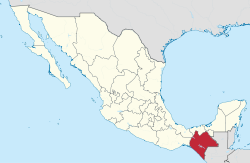This article has multiple issues. Please help improve it or discuss these issues on the talk page . (Learn how and when to remove these messages)
|
| Golden fuchsia | |
|---|---|
 | |
| Scientific classification | |
| Kingdom: | Plantae |
| Clade: | Tracheophytes |
| Clade: | Angiosperms |
| Clade: | Eudicots |
| Clade: | Asterids |
| Order: | Gentianales |
| Family: | Rubiaceae |
| Genus: | Deppea |
| Species: | D. splendens |
| Binomial name | |
| Deppea splendens | |
 | |
| Deppea splendens was endemic to Chiapas, Mexico [3] | |
| Synonyms [4] | |
| |
Deppea splendens, also known as the golden fuchsia, [5] [6] is a species of flowering plant in the family Rubiaceae endemic to Chiapas, Mexico. [3] It is extinct in the wild. [1] [3] Despite its common name, it is not closely related to true Fuchsia . [7]
